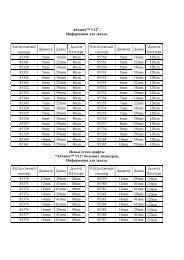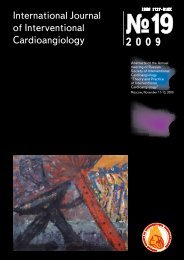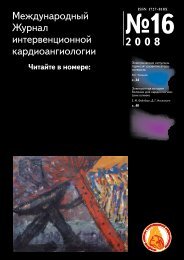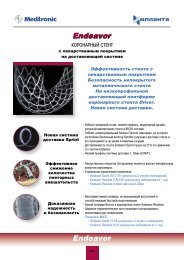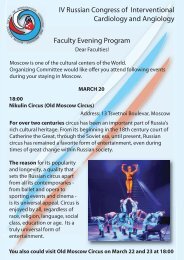Results of Coronary Stenting using the Stents with
Results of Coronary Stenting using the Stents with
Results of Coronary Stenting using the Stents with
You also want an ePaper? Increase the reach of your titles
YUMPU automatically turns print PDFs into web optimized ePapers that Google loves.
Cardiology<br />
Distribution <strong>of</strong> cases by sex and age in TLT group<br />
Table 1.<br />
Sex 41 – 50 51 – 60 61 – 70 > 71 Total<br />
Абс % Абс % Абс % Абс % Абс %<br />
Males 2 4% 8 16% 9 18% 9 18% 28 56%<br />
Females 0 0 6 12% 7 14% 9 18% 22 44%<br />
Total 2 4% 14 28% 16 32% 18 36% 50 100%<br />
Distribution <strong>of</strong> cases by sex and age in non-TLT group<br />
Table 2.<br />
Sex 41 – 50 51 – 60 61 – 70 > 71 Total<br />
Абс % Абс % Абс % Абс % Абс %<br />
Males 13 7,2% 35 19,4% 38 21,1% 31 17,3% 117 65%<br />
Females 0 0 18 10% 25 13,8% 20 11,2% 63 35%<br />
Total 13 7,2% 53 29,4% 63 35% 51 28,4% 180 100%<br />
90<br />
80<br />
70<br />
60<br />
50<br />
40<br />
30<br />
20<br />
10<br />
0<br />
2-3 CA thrombi 1 CA thrombi<br />
non-TLT 68 57 32 83<br />
TLT<br />
64<br />
38 36 28<br />
nent (HC) in <strong>the</strong> myocardial infarction area (<strong>with</strong>in <strong>the</strong><br />
central sites <strong>of</strong> a formed necrotic focus).<br />
The intensity <strong>of</strong> HC in <strong>the</strong> myocardial necrotic<br />
focus was different.<br />
The cases <strong>with</strong> diffusely dark-red coloration <strong>of</strong> <strong>the</strong><br />
necrotic zone appearing <strong>with</strong>in <strong>the</strong> first hours after<br />
<strong>the</strong> onset <strong>of</strong> <strong>the</strong> disease (min. 2 hours) were considered<br />
as hemorrhagic myocardial infarction (HMI) —<br />
such cases made 12% (6 <strong>of</strong> 50). Commonly HMI<br />
non-TLT<br />
TLT<br />
Fig. 1. The rate <strong>of</strong> stenotic a<strong>the</strong>rosclerosis in thrombosis in <strong>the</strong> coronary<br />
branches<br />
IMI<br />
72%<br />
HM<br />
12%<br />
IMI <strong>with</strong> HC<br />
16%<br />
Fig. 2. The rate <strong>of</strong> various forms <strong>of</strong> myocardial infarction in<br />
<strong>the</strong> TLT group.<br />
was located transmurally,<br />
somewhat less frequently —<br />
subendocardially and subepicardially<br />
(Fig. 3). As a rule, <strong>the</strong><br />
HMI had clear borders, a faint<br />
pale-yellow peri-infarction<br />
area <strong>of</strong> varying width was seen<br />
at <strong>the</strong> periphery <strong>of</strong> <strong>the</strong> focus;<br />
this zone had ra<strong>the</strong>r distinct<br />
boundaries <strong>with</strong> <strong>the</strong> preserved<br />
myocardium.<br />
In 16% <strong>of</strong> <strong>the</strong> o<strong>the</strong>r cases<br />
(8 <strong>of</strong> 50) <strong>the</strong> infarction was represented<br />
by a faint pale-yellow<br />
focus <strong>with</strong> distinct borders and<br />
multiple merging dark-red hemorrhages — an<br />
ischemic myocardial infarction <strong>with</strong> hemorrhagic<br />
component (IMI <strong>with</strong> HC). Most commonly<br />
<strong>the</strong> hemmorhages were revealed in <strong>the</strong><br />
peripheral segments <strong>of</strong> <strong>the</strong> focus, somewhat<br />
less frequently — in its central area (Fig. 4).<br />
Ischemic myocardial infarction (IMI) was<br />
found in 72% <strong>of</strong> cases (36 <strong>of</strong> 50) in <strong>the</strong> TLT<br />
group (Fig. 5).<br />
Unlike <strong>the</strong> TLT group, ischemic infarction<br />
(<strong>with</strong>out hemorrhagic component) was found<br />
in all 180 cases in <strong>the</strong> non-TLT group. Within <strong>the</strong><br />
first hours <strong>the</strong> IMI ei<strong>the</strong>r could not be revealed<br />
macroscopically, or its area seemed somewhat<br />
paler than <strong>the</strong> surrounding myocardium. Only by <strong>the</strong><br />
end <strong>of</strong> <strong>the</strong> first day <strong>the</strong> infarction’s borders became<br />
relatively distinct, and its color changed to faint paleyellow.<br />
No hemorrhages were seen nei<strong>the</strong>r in <strong>the</strong><br />
center, nor at <strong>the</strong> periphery <strong>of</strong> <strong>the</strong> focus.<br />
We analyzed <strong>the</strong> association <strong>of</strong> hemorrhagic<br />
component in <strong>the</strong> myocardial infarction area <strong>with</strong><br />
<strong>the</strong> absence on intracoronary thrombus in <strong>the</strong> IRA.<br />
Morphogenetic Particularities <strong>of</strong> Acute Myocardial Infarction <strong>with</strong> and <strong>with</strong>out Early Thrombolytic<br />
Therapy<br />
53





